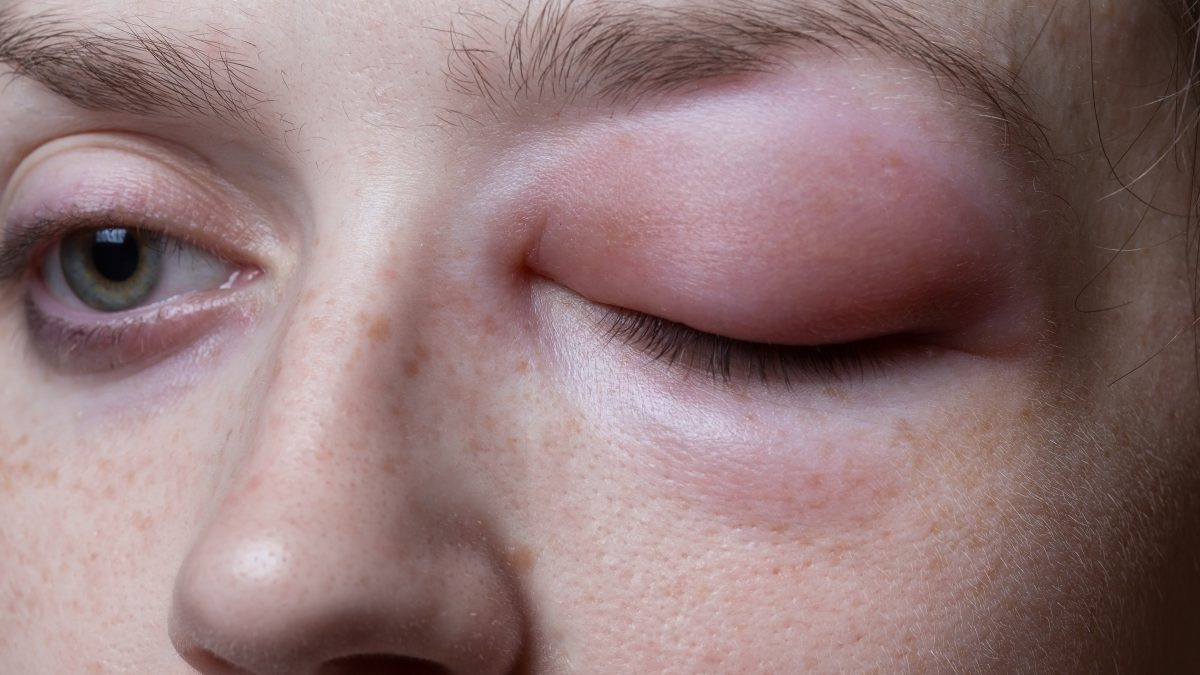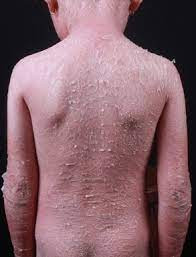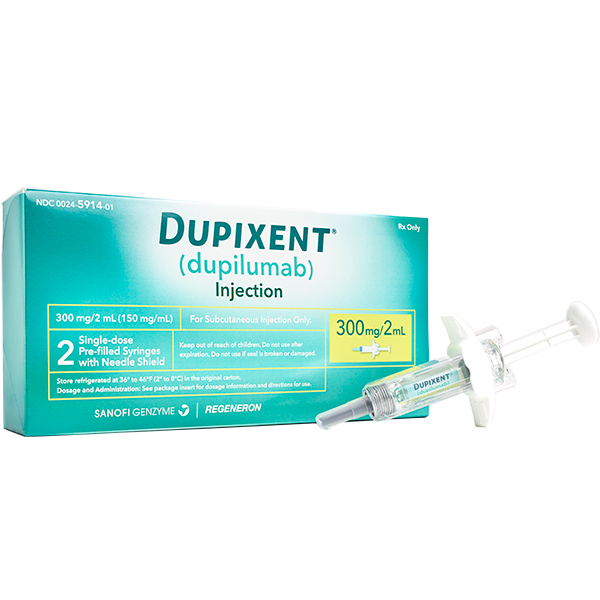Definisi
Eritema multiformis adalah reaksi hipersensitivitas kulit berupa kemerahan atau ruam yang menyerupai bentuk lingkaran target. Berasal dari bahasa latin, eritema berarti kemerahan, multi berarti banyak, dan forme berarti bentuk; sehingga eritema multiformis adalah gejala kemerahan pada kulit dalam berbagai bentuk. Tampilan paling umum dari penyakit ini adalah ruam berbentuk lingkaran dengan bagian yang gelap di tengahnya, menyerupai papan 'target'.
Ruam ini dapat muncul setelah:
- Mengalami infeksi tertentu, seperti infeksi herpes simpleks, infeksi bakteri Mycoplasma pneumoniae, dan kuman lainnya
- Mengonsumsi antibiotik golongan penisilin, sefalosporin, dan obat antituberkulosis
- Berkontak dengan bahan herbal
- Terkena atau terpapar logam
- Vaksinasi
Eritema multiformis dapat terjadi pada berbagai usia, namun lebih sering terjadi pada usia dewasa muda. Rata-rata usia pasien eritema multiformis adalah 20–30 tahun dan sekitar 20% kasus terjadi pada anak-anak. Laki-laki lebih sering mengalami eritema multiformis dibandingkan perempuan dalam rasio 5:1. Angka kejadian eritema multiformis cukup kecil, yaitu sekitar 1% dari populasi dunia.
Eritema multiformis memiliki 2 bentuk, yaitu:
- Eritema Multiformis Minor
Kondisi ruam kemerahan pada kulit yang ringan. Gejala hanya terbatas pada lesi kemerahan pada kulit yang disertai gatal dan tidak melibatkan selaput lendir (tidak ada sariawan, gangguan penglihatan, dan lain-lain).
- Eritema Multiformis Mayor
Kondisi ruam kemerahan pada kulit yang juga melibatkan selaput lendir (membran mukosa). Kondisi ini lebih berbahaya dan berpotensi mengancam jiwa.
Penyebab
Penyebab dari eritema multiformis masih belum jelas, namun beberapa kasus menunjukkan bahwa eritema multiformis muncul setelah penggunaan obat-obatan atau terinfeksi kuman tertentu. Eritema multiformis bukan merupakan penyakit yang menular dari satu orang ke orang lainnya. Penyebab dari eritema multiformis antara lain:
Infeksi
Infeksi penyebab umumnya adalah infeksi virus seperti virus herpes simpleks. Setelah menginfeksi, virus ini bisa berdiam atau 'tidur' di dalam tubuh dan dapat kembali aktif beberapa tahun kemudian. Gejala awalnya adalah sariawan di sekitar bibir yang diikuti dengan gejala eritema multiformis setelah beberapa hari. Eritema multiformis juga dapat dicetuskan oleh infeksi bakteri Mycoplasma sp., yaitu bakteri yang dapat menyebabkan infeksi pada paru-paru.
Obat-obatan
Obat-obatan dapat menyebabkan eritema multiformis yang berat. Obat-obatan yang sering menyebabkan reaksi ini antara lain:
- Antibiotik, seperti tetrasiklin, amoksisilin, dan ampisilin
- Antinyeri, seperti ibuprofen
- Antikejang, seperti fenitoin dan barbiturat
Vaksin
Beberapa laporan kasus melaporkan terjadinya eritema multiformis setelah infeksi MMR, cacar, varisela, influenza, dan DPT. Namun, angka kejadian ini rendah.
Faktor Risiko
Faktor-faktor yang dapat meningkatkan risiko mengalami eritema multiformis, antara lain:
- Laki-laki, usia dewasa muda (20-30 tahun)
- Memiliki gangguan sistem kekebalan tertentu, seperti:
- Mengalami HIV atau penyakit autoimun
- Sedang mengonsumsi obat-obatan penurun sistem imun (kortikosteroid)
- Transplantasi sumsum tulang belakang
- Mengalami keganasan atau kanker seperti leukemia atau limfoma
Gejala
Gejala ruam atau kemerahan pada kulit dapat terjadi dalam waktu beberapa hari setelah paparan atau infeksi. Ruam kulit berbentuk target ini muncul pada kaki atau tangan, kemudian menyebar ke lengan, badan, dan wajah. Gejala kemerahan akibat eritema multiformis memiliki karakteristik seperti:
- Ruam kemerahan dimulai seperti bentuk titik-titik merah yang kemudian akan menimbul dan membesar (ukuran dalam rentang sentimeter)
- Bentuk kemerahan terlihat seperti target dengan area yang lebih gelap di tengahnya, terkadang bagian tengah ini terlihat berwarna merah tua atau terdapat kerak kekuningan yang dikelilingi oleh bagian yang lebih pucat
- Menimbulkan rasa gatal atau tidak nyaman
- Hilang setelah 2-4 minggu
- Pada kondisi yang lebih berat, ruam kemerahan tersebut dapat bergabung membentuk satu area kemerahan yang besar, merah, dan nyeri.
Gejala lain yang dapat menyertai ruam kulit tersebut adalah:
- Demam tinggi
- Nyeri kepala
- Sariawan pada mulut yang nyeri dan membuat makan atau minum menjadi sulit dilakukan
- Bibir membengkak dengan kerak di sekitarnya
- Nyeri pada kemaluan sehingga ketika buang air kemih menjadi terasa sakit
- Mata merah dan nyeri
- Sensitif terhadap cahaya
- Pandangan buram
- Nyeri pada sendi
Diagnosis
Diagnosis ditegakkan oleh dokter berdasarkan gejala yang dialami dan pemeriksaan fisik pada kulit, mulut, mata, paru-paru, dan alat kelamin (genital). Pada eritema multiforme yang khas, dokter dapat menegakkan diagnosis dengan melihat pola kelainan pada kulit. Jika dokter ragu, dokter akan melakukan pemeriksaan tambahan berupa:
- Pemeriksaan darah
- Pemeriksaan fungsi hati
- Penanda inflamasi
- Pemeriksaan serologis untuk infeksi tertentu
- Pemeriksaan pencitraan dengan sinar X
- Biopsi kulit, pengambilan sampel jaringan kulit untuk diperiksa di bawah mikroskop
Semua pasien dengan gejala eritema multiformis harus melalui pemeriksaan herpes simpleks dengan mengambil sampel dari kulit atau selaput lendir. Pada kasus eritema multiformis yang berulang atau tidak kunjung sembuh, dokter akan melakukan pemeriksaan lanjutan untuk mencari kemungkinan penyakit lain yang mungkin mendasari munculnya gejala.
Tata Laksana
Dokter perlu menentukan penyebab dasar dari eritema multiformis sebelum melakukan pemeriksaan lanjutan. Dokter juga akan memberikan pengobatan yang dapat meredakan gejala dan menghentikan proses peradangan kulit serta infeksi yang terjadi. Dokter akan melakukan beberapa hal berikut:
- Menghentikan pemberian obat pada pasien yang diduga menyebabkan eritema multiformis, pengobatan tidak boleh asal dihentikan tanpa berkonsultasi terlebih dahulu dengan dokter
- Memberikan obat minum dan krim pelembab untuk meredakan gejala gatal
- Krim steroid untuk mengurangi gejala kemerahan dan pembengkakan pada kulit
- Obat pereda nyeri jika terdapat nyeri pada kulit
- Dokter dapat memberikan obat antivirus jika dokter menduga eritema multiformis yang Anda alami dicetuskan oleh infeksi virus
- Obat kumur jika terdapat sariawan, untuk mengurangi nyeri dan rasa tidak nyaman di dalam mulut
Pada kondisi eritema multiformis yang lebih berat, dokter akan meminta pasien untuk dilakukan rawat inap dan pemantauan. Selama perawatan, dokter akan memberikan:
- Obat pereda nyeri yang lebih kuat
- Cairan infus
- Perawatan luka untuk mencegah infeksi pada kulit
- Mengganti makanan menjadi makanan cair jika diperlukan
- Memberikan steroid untuk meredakan peradangan
- Pengobatan pada mata jika terdapat reaksi peradangan pada mata
Komplikasi
Sebagian besar pasien dengan eritema multiformis dapat sembuh sempurna dalam beberapa minggu. Umumnya tidak ada komplikasi lanjutan dan kulit dapat sembuh tanpa meninggalkan bekas luka.
Terdapat risiko eritema multiformis akan berulang dalam beberapa waktu ke depan, terutama jika eritema multiformis disebabkan oleh infeksi virus herpes simpleks. Selain itu, bila kondisi eritema multiformis sudah cukup berat, bisa terjadi beberapa komplikasi seperti:
- Kondisi infeksi berat di mana bakteri masuk ke dalam pembuluh darah dan menyebabkan kegagalan fungsi berbagai organ
- Infeksi kulit selulitis, yaitu kondisi yang menyebabkan kemerahan, pembengkakan, dan nyeri pada area kulit yang terkena
- Bekas luka dan kerusakan kulit permanen
- Gangguan mata permanen
- Peradangan terus menerus pada berbagai organ yang dapat mengganggu fungsi organ-organ tersebut, seperti hati dan paru-paru
Pencegahan
Eritema multiformis tidak dapat dicegah. Bila kondisi eritema multiformis disebabkan oleh infeksi herpes simpleks, Anda dapat mencegah berulangnya kondisi tersebut dengan melakukan pengobatan herpes simpleks secara tuntas. Jika dokter telah menemukan pencetus eritema multiformis yang Anda alami, hindari berkontak dengan bahan atau zat pemicu reaksi alergi tersebut di kemudian hari.
Kapan Harus ke Dokter?
Segera berkonsultasi dengan dokter jika Anda atau orang di sekitar Anda mengalami gejala ruam kulit yang sudah berlangsung selama beberapa waktu, khususnya bila Anda turut mengalami gejala seperti demam, nyeri kepala, pembengkakan, atau gangguan pada mata. Dokter akan melakukan pemeriksaan untuk memastikan kondisi ini sebelum memberikan penanganan lebih lanjut.
Mau tahu informasi seputar penyakit lainnya? Cek di sini, ya!
- dr Hanifa Rahma
Benedetti, J. (2020). Erythema multiforme. MSD Manual Consumer Version. Available from: https://www.msdmanuals.com/home/skin-disorders/hypersensitivity-and-inflammatory-skin-disorders/erythema-multiforme
Hafsi, W., Badri, T. Erythema Multiforme. [Updated 2021 Aug 7]. In: StatPearls [Internet]. Treasure Island (FL): StatPearls Publishing; 2022 Jan-. Available from: https://www.ncbi.nlm.nih.gov/books/NBK470259/
National Health Service. (2019). Erythema multiforme. Available from: https://www.nhs.uk/conditions/erythema-multiforme/
King, C. (2022). Erythema Multiforme. DermNet NZ. Available from: https://dermnetnz.org/topics/erythema-multiforme
Trayes, KP. (2019). Erythema multiforme: recognition and management. Am Fam Physician;100(2):82-88. Available from: https://www.aafp.org/afp/2019/0715/p82.html












